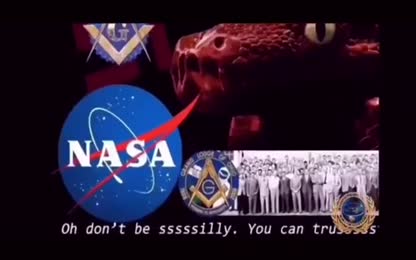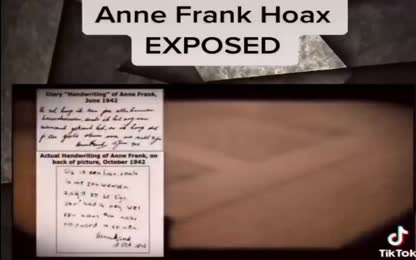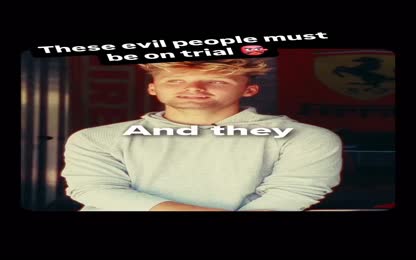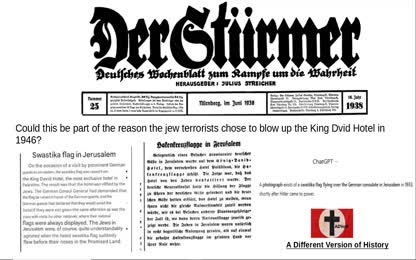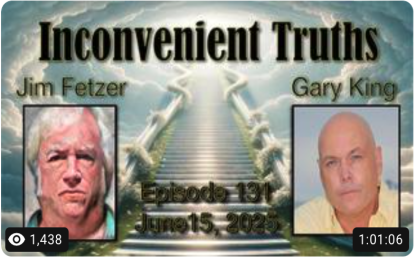Advertisement
Holohoax - David Cole - The Truth Behind the Gates of Auschwitz - holocaust
David Cole - The Truth Behind the Gates of Auschwitz - holocaust - holohoax
For educational purposes.
- Category: Uncategorized,Hitler / World War II,War/MilitaryIndustrialComplex,Zionism
- Duration: 53:16
- Date: 2018-06-11 17:20:51
- Tags: ww2, history, europe, germany, revisionism, holocaust, holohoax
2 Comments
Video Transcript:
fact of history that during World War II the Germans ran a network of prison and labor camps both in Germany and in the territories they controlled. Into these camps were sent Jews, prisoners of war, resistance fighters, yipses, and other people considered enemies of the Third Reich. The largest of these camps was the one called Auschwitz, located in Poland. This in turn did Auschwitz came from all over Europe and consisted of men, women, and children. Those able to work were used as labor for the German war effort. Auschwitz was liberated by the Soviet army in January of 1945. But that is where the consensus ends. Since the end of World War II we have been told repeatedly that many of these camps served a darker purpose. The genocide of 6 million Jews and the execution of 5 million non-Jews through the use of homicidal gas chambers in what is now commonly known as the Holocaust. The largest number of people are said to have been murdered at Auschwitz. But there are some people who maintain that these claims of mass murder have never been proven. These people point to the lack of documentation other than the highly questionable and already partially discredited evidence supplied by the Soviet Union at the Nuremberg trial. And the unreliable nature of the eyewitness testimonies, many of which have also been discredited. For example, many former campin mates, as well as American soldiers, still speak of gassings at the Dachau camp in Germany, even though it is no longer held that any gas chamber was ever in use at that camp. Still, the Holocaust is an event that has seemingly grown in importance since the end of the war. Tawd is fact, usually accepted without question. But how do we know if it really happened? What proofs are offered for those not willing to take history on faith alone? This video deals with, among other things, one of those proofs. One piece in a very large puzzle. The supposed gas chamber at the Auschwitz Main Camp. This tape is the first in a series of tapes covering my September 1992 trip to Europe, to investigate firsthand the sites of the alleged final solution. It is by no means intended to be the last word on the Holocaust controversy, but just the opposite. I hope this tape can begin an open debate that's long overdue. What is fact and what is simple wartime propaganda regarding the event we have come to know as the Holocaust? This is the Auschwitz Main Camp or Stumlogger. There are three parts to what is known as Auschwitz. There is Auschwitz I, the Main Camp, a well-built compound which existed before World War II as a military barracks and was slightly modified by the Germans when they took it over. Then there is Auschwitz II, also known as Auschwitz Burkinau, which was constructed during the war as an expansion of the Main Camp. And there is Auschwitz III or Auschwitz Monowitz, a large industrial area where many inmates were forced to work. It is Auschwitz I, the Main Camp, which is the center of Auschwitz tourism. It is here that tours are conducted hourly in English, Polish, German and French. By their own figures, over half a million people visit here every year, and the place has become a curious shrine, a mix of craft commercialism and religious reverence, with a hotel, restaurant, a rooftop shop, and booths selling all manner of video equipment, like batteries and videotapes in all formats, so that no one need worry about missing a shot of the final solution. This is a shrine which combines Catholic expressions of identity and mourning with Jewish ones, and this is traditionally caused some tension. Jewish groups have charged that the Poles downplay the role of Jewish suffering, and while few would openly suggest it, it could be said that, in the West, Jews have attempted to monopolize Auschwitz as a uniquely Jewish experience. Already we reach an important point in our examination of the Holocaust. It is an event interpreted differently in various corners of the world. The Soviets have always stressed the suffering of Russians, Poles, Ukrainians and others. Most World War II Soviet propaganda films often made little mention of Jews. To the Polish locals, Auschwitz is given a Catholic face, with all the usual fetishes. The suffering of Polish priests and other martyrs is stressed, and the attempted extermination of the Polish people is the preferred theme. But in the Western world we get a single-mindedly Jewish interpretation, with the non-Jewish deaths being used mainly to keep non-Jewish interest in the Holocaust alive by giving non-Jews some involvement in it. But we are told that even though non-Jews suffered as well, it is the Jews and the Jews only who were marked for extermination. This schism has often resulted in well-publicized disputes, such as the Convent of Carmelite Nuns who took up residence here at Auschwitz against the wishes of many Jewish groups, and the time a touring Polish Auschwitz exhibit was protested for not being Jewish enough. However, at the camp itself there is more than enough victimization to go around. The layout of the Auschwitz main camp is fairly simple, a square of barbed wire fence, surrounds rows and rows of inmates barracks, a large mess hall, and a few surprises which we will get to later. Outside the fence in area are the SS headquarters these two buildings, and the SS hospital and restaurant, across from that is the building known as Crematorium I, the infamous Gas Chamber and Crematorium. Most of the inmates barracks have been converted into museums, which make up the bulk of the guided tour. The rest of the barracks are used as either archives or offices for museum staff. One barrack, block 11, has been kept in its original state. It was the camp prison, and it is now referred to naturally as the block of death, which brings up another interesting point, what is shown on the tour and what is not. During the tour you are shown the block of death, the so-called wall of death naturally right next door to the block of death, and exhibit after exhibits specifically designed to affirm atrocity stories, and portray Auschwitz as a death machine, a place where internment extermination. But what don't they show you? To start with, a building which could conceivably be called the block of life. A massive disinfestation complex where Zyclonbeak-ass was used daily to combat lice and the disease they carried. These were the real gas chambers, except their victims were clothing and mattresses, and their purpose was to preserve the health of the inmates. Holocaust experts don't deny the purpose of this building, they just don't like mentioning it, after all, why complicate things. Also forgotten is the Auschwitz camp theater, the current home of the aforementioned Convent of Nuns. The last pictures taken inside this building showed pianos and costumes and a stage where the inmates used to put on productions. These days, however, the nuns don't allow pictures to be taken inside. And finally we have the Auschwitz swimming pool. Yes, that's right, swimming pool, situated inside the prison compound, right alongside the inmates barracks, a beautiful pool with a diving board and starters blocks for races. To their credit, the Auschwitz camp officials have not tried to remove this distraction, but if you want to see the pool, you need to know already that it exists, because you won't find it on the tour. So basically, what we have is a tour that consists mainly of tourists who already believe in the Holocaust story, and are perhaps emotionally connected to it in some way, being given a selectively edited tour filled with horror story after horror story and ending up at the final stop, the gas chamber. At that point, the tour group is emotionally primed to believe anything, and the gas chamber is like the featured performer after a two-hour warm-up act to get the crowd in the mood. Literally the gas chamber is the objective proof that everything they've heard on the tour is true, objective proof of the Holocaust, but is it? We'll see in a minute. I went to Auschwitz in September of 1992 to see for myself this place that I have studied for so long. I paid extra for a personal English language tour guide, a young lady named Alicia who gives tours in Polish, German, and English, and I wore my Yomelka, just so nobody missed the point that I'm Jewish. I figured that way I could ask my questions in a manner that would not make me look like a revisionist. You see, in the past revisionists haven't had much success in getting answers from the Auschwitz officials, but I would come off as a righteous Jew wanting to know the real facts and answer those who say the Holocaust never happened. For the sake of clarity, not only am I a revisionist, I am also quite proudly an atheist, but my parents are both Jewish, so if you're a Jew by birth, you're a Jew by birth, it's not anything I'd be ashamed of. Alicia, like the other tour guides, had to take a class and memorize a spiel to become one. This is an important point because I'm hoping to show that the people who run Auschwitz, like Dr. Franschek Pieper and the tour guides supervisor, you'll meet shortly, teach their tour guides to say things they know aren't true, but this shouldn't reflect badly on Alicia. She only repeats what she's been told, and I'm sure she never had to put up with a tourist like me before. I have over four hours of footage of me taking the tour, asking one obnoxious question after another. This footage will be re-edited into a separate tape. This time we're just going to concern ourselves with the gas chamber, and my interview with Dr. Franschek Pieper, Senior Curator and Head of Archives at the Auschwitz State Museum. I came to Auschwitz as a confirmed skeptic about the gas chamber story. I notice some people critically examining the Holocaust is the ultimate sacrilege, but you'll have to realize that I have no sacred cows, and understanding what really happened is important to me, and I'd ask that you respect that. I know from years of my own research, and the research of others, that proofs of the Holocaust are few. Literally, all there is are the eyewitness testimonies and post-war confessions. There's no picture, plan, or wartime document dealing with homicidal gas chambers, or a plan to exterminate the Jews. And we can't use the excuse that the Nazis destroyed all the evidence, because after we had broken the German code, we were able to intercept their secret transmissions, including those that came from Auschwitz. The key to understanding the Holocaust story is understanding the true nature of the things passed off as proofs. Everything that is used as evidence of the Holocaust also can be said to have a perfectly normal explanation. For example, these exhibits are said to be the material proofs of exterminations. There's the piles of human hair. But what does that prove? It's acknowledged that each inmate had his or her head shaved because of the lice problem. That's not denied, so why wouldn't there be piles of human hair? What about the piles of shoes and clothing? Is that a proof? It's a fact that the prisoners were issued a uniform upon arrival, including shoes. So why wouldn't there be piles if inmate's shoes and clothing? It doesn't prove anybody was killed. And that's giving the Soviets and Poles the benefit of the doubt that the clothes and hair are genuinely from the camp during its operation. What about the canisters of gas? No one denies that Cyclone B was used to disinfect clothes and also buildings. Cyclone B was one of the premier pest control agents in Europe at that time. It was present in most of the concentration camps, including those that are not said to have had homicidal gas chambers in them. The typhus epidemic that spread throughout Europe during the war and also spread through the camps called for stringent lice control procedures. In his book Auschwitz Technique and Operation of the Gas Chambers, published by the Klarzfeld Foundation and meant to refute revisionists, Jean-Claude Prissac admits that over 95% of the Cyclone B used by the Germans was used to disinfect. He assigns only 5% to homicidal purposes, and this from a Holocaust supporter. So what other proofs are offered? Well there's the usual pictures of sick inmates, which proves the groundbreaking thesis that people got sick in the camp, once again I'll add that nobody denies the typhus epidemic, which resulted in many deaths. Then there's the artwork and the pictures of children, but at this point it's looking pretty bad for somebody looking for objective proofs of the gas chamber, and some of the proofs they present actually work against the concept. For example, they have one of several aerial photographs taken of Auschwitz by the allies during the war. They don't mention however, that when blown up, these photos don't show people being gassed or bodies being burned, even though they were taken during the time killings were said to be going on almost nonstop. I won't even go into the special money the Germans printed for Auschwitz inmates, or the fact that even though it is said that Jewish children were killed immediately, both Anne Frank and her sister were sent to Auschwitz and survived, later being transferred to the Bergen-Belsen camp where they are said to have died from typhus. But all this bickering would be pointless if we could see a genuine gas chamber for ourselves, that of course would most effectively end the argument. Which brings us to the building I'm standing in front of, the gas chamber and cream of the war, pictures of this building have been featured in book after book on the Holocaust. After all, what better proof it all happened. Revisionists don't dispute that this is a real building from during the war. We say that it was a real building, but it is not a real building. It is a real building, but it is a real building. It is a real building, but it is a real building. Revisionists don't dispute that this is a real building from during the war. We say that it was indeed a crematorium and a mortuary, which also was used as an air aid shelter for the SS men in the hospital and restaurant right across the street from it. The Auschwitz people say it was indeed a mortuary and a crematorium, with a mortuary part which you're looking at right there, later being used as the gas chamber. They also say that it was used as an air aid shelter. And they have, in the past, admitted that the large brick chimney at the side of the building is a reconstruction, which is no big shock to anybody because it clearly isn't connected to the building in any way. Now let's go inside. Once inside we can see why revisionists have had such a field day with this building. Obvious marks on the walls and floors, where apparently walls had been knocked down. Only obvious holes in the floor where bathroom facilities had been. We maintain that, unlike the large hollow chamber we now see, this room had once been five rooms, including a bathroom. I should add that there is no Zyclon B-Blue staining in the walls, as there would have been with repeated Zyclon B-Use and as there were and still are in the disinfestation chambers. A flimsy wooden door with a big glass pane in it. And the doorway with no door and no fittings for a door leading to the crematorium ovens. And I should also mention the big manhole right in the middle of the gas chamber. Yet the building does have what appears to be evidence of criminal usage. Four holes in the ceiling, which lead to the roof, where four little chimneys stand. They said that through these four holes, Zyclon B-Crystals were dropped. And indeed there seems to be no other explanation for them. Do these holes prove homicidal gassings? Revisionists have claimed in the past that these holes were added after the camp's liberation, and that the inside walls were knocked down and the bathroom facilities removed to make the room look like a big gas chamber. As Alicia and I approached the building, we passed the gallows where the common d'ant of Auschwitz Rudolf Huss was hanged by the Soviets in 1947, executed directly in front of the evidence of his crime. Here in front of the gas chamber, I ask Alicia about the authenticity of that building. Now let's start again talking about this building here. This is a crematorium gas chamber. But this is a reconstruction. It is in original state. Now there, Alicia has very clearly represented the gas chamber as being in its original state. Once inside, I asked her specifically about the four holes in the ceiling. Are those original holes in the ceiling? It is in original part. Original in the Prodice Gymnay Wallstrop Cyclone Bay. I then asked Alicia if any walls had ever been knocked down in the room exhibited as the gas chamber. So this part was on the gas chamber? Were there walls here at one time? But here it was only one room. That here I know here, when here I show picture of gas chamber, it was only one room here. No. Let's pause here to recap the gas chamber according to our tour guide. She states that the room is in its original state. That the ceiling holes are original. And that no walls were knocked down. Unsatisfied with her answers, I continued to bat your poor Alicia about the real history of this room. Feeling somewhat exasperated at the fact that nothing she could say would shut me up, Alicia went to get a woman who was introduced to me as the supervisor of tour guides for the Auschwitz State Museum. When I saw this woman approach, I figured I was either going to get a straight answer or kicked out of the camp. This is what I can suggest. It will be much better to go to our scientists in the state museum and to talk with. They show you a lot of plants which we still have in the archives. Where would that be? I don't think that it's open today, but probably in Monday it will be possible. That's the Auschwitz State Museum? Yes. Is that in Auschwitz? Here. In block number 24 and 23, I'm not sure about it. Would it be possible for me to make an appointment to see him on Monday, perhaps? That's true. So, it was here that it was first suggested I meet with the head of archives and senior curator, Dr. Franchi Chek Piper. Still, fearing that such a meeting might not come about and assuming that the supervisor was probably in the loop regarding any reconstructions, I decided to get her input regarding the supposedly original holes in the ceiling. Are those the original holes in the ceiling? No. They've been rebuilt? Yes. Okay, after the war. After the war. So, if you're keeping score, that makes it one vote for original? One vote for not original? I guess that would make Dr. Piper the tiebreaker. Now, before we proceed any further, a little digression is needed about some genuine Holocaust revisionism. Dr. Franchi Chek Piper is one of the Holocaust experts, most directly responsible for the lowering of the Auschwitz death count. Along with other scholars like his Rayleigh Holocaust expert Dr. Yehuda Bauer, it was decided around 1989 to admit publicly that fewer people died at Auschwitz than had previously been reported. In his book Auschwitz How Many Parished, Dr. Piper concludes that the old Soviet provided figure of four million is wrong, and that the real figure is closer to 1.1 million. Now that's no small revision, and admission that the Soviets exaggerated the figure by almost four times. We can also see how the fraudulent figure has been an ingrained part of supposedly factual Holocaust history for almost 50 years. As late as 1988, in the official Auschwitz State Museum guidebook, you'll find on page 19 an official affirmation of the four million figure. The Soviet State Extraordinary Commission for the investigation of Nazi crimes stated that no less than four million people perished in Auschwitz, the Supreme National Tribunal in Poland stated that about four million persons perished in Auschwitz, according to the International Military Tribunal in Nuremberg, more than four million persons perished in Auschwitz, and these figures are based upon the evidence of hundreds of surviving prisoners and upon the opinion of experts. Well, this shows that not only was fraudulent Soviet evidence admitted as fact at Nuremberg, but also that survivors and experts can be wrong. And if it matters, many Holocaust revisionists believed that the actual total of dead at Auschwitz is even less than 1.1 million. But still, there is no possibility that even the most extreme Holocaust revisionist in the world could possibly revise the figure any more than the Holocaust experts already have. Which rather neatly brings us to this man, Dr. Frontier-Check-Peper. I interviewed him in his office at the Auschwitz State Museum. At first, he was a little apprehensive about being videotaped. But I explained to him that since I already had the tour guide on tape, giving out what I had now come to believe was incorrect information, I should have a videotape which could set the record straight. Once he consented, I immediately asked him about changes made in the gas chamber. So first, since all of this gas chamber, which existed in Auschwitz I, this can go on now here, operate this problem at all 10, 1941 to December 1941 to approximate the one here. In 1944, in collection, with the bombardment of Auschwitz by Allies Air Forces, empty crematorium number one in the gas chamber, Auschwitz one were adopted as air shelter. The times additional walls were built inside the gas chamber. The additional entrance was made from the east side of the gas chamber. And the openings were the ceiling, the gas site on the back was discharged inside the wall as a time liquidated. So after the liberation of the camp, the former gas chamber presented the view of the shelter. In order to gain the earlier view, earlier side of this object, the inside walls built in 1944 were removed and the opening of the ceiling were made in the annual. So now this gas chamber is very similar to this one which existed in 1941, 1942. But not all details were made as such. So there is no bestite, those for instance, additional entrance from the east side, but as it was made in 1944, such changes were made here. Outers of war in order to gain the earlier view of this object. Here I think we should recap what Dr. Piper has told us. According to him, the room was a gas chamber but was later turned into an air-raid shelter. At which time dividing walls were built, the holes in the ceiling were removed and a new door was added on one side of the gas chamber. However, after the camp's liberation the dividing walls were knocked down, the holes were put in the ceiling however the new door was not removed. I think here there are three main points that have to be made. The first of these is that we are looking at a clear deception. As I have shown, the gas chamber is shown off to tourists as being in its original state, even though the museum officials know better. Dr. Piper appears to be very nonchalant about the fact that changes were made after the war, but if it isn't such a big deal then why hide it from the tourists? And that's not all. In May of 1992 British historian David Irving was fined by a German court for telling a meeting in Munich exactly what you've just heard Dr. Piper tell you. In fact, Piper was even called as a defense witness, but the judge wouldn't allow him to testify even though it might have cleared Irving. Once again I'll say if this is not such a big deal why find somebody for saying it? Our next point is the gas chamber is no longer valid as proof in its present state. It is not a proof of homicidal gassings unless it can be shown net at some time during the war. This building had four holes in the ceiling and no dividing walls during the time the Germans were operating the camp, which brings us to our final point. The reconstruction itself with the information we now have we can say that there are two different views of the gas chamber reconstruction. The first one the official view holds that the Soviets and Poles created a gas chamber in an air raid shelter that had been a gas chamber. The revisionist view holds that the Soviets and Poles created a gas chamber in an air raid shelter that had been an air raid shelter. So how do we know which one is correct? Well obviously the burden of proof is on those who say that there was a gas chamber at one time in that building. Do they have any evidence at all to support that claim? In my tenure as a holocaust revisionist I'm sure if there was any I'd have seen it. I can also add that those questionable four holes in the roof of the building are not detectable in any of the aerial photograph blowups that I've seen. To get to the truth of this matter there are some other pertinent questions that can be asked. If there was at one time a functioning gas chamber in this building why was its operation halted especially if the Nazis were running out Schwitz as an extermination center? Well Dr. Piper has an answer for that one too. In an essay published in the Polish book Auschwitz Piper writes that exterminations were moved to new gas chambers in the Auschwitz Birkenau complex because it had become too difficult to keep the gas chamber at the Auschwitz main camp a secret from the inmates. This has apparently become part of official Auschwitz law because it's something that Alicia repeated to me on the tour. In spite of this crematorium was next to blocks where the prisoners lived that's why extermination was moved to Birkenau. That's why four crematoriums with gas chambers were built in Birkenau. Now let's be perfectly clear about this. They say that exterminations were moved to Birkenau because the gas chamber at the main camp was too close to the inmates and therefore they could know what was going on. But is this even remotely accurate? Let's refer back to our map of the main camp. Now here's the gas chamber right there. And there's the rows of inmates barracks. As you can see the gas chamber is well outside of the prison compound and is hidden from view by the three SS buildings which effectively hide it from the inmates site. Plus we're told that arrivals who are going to be gas would be taken in through here thus avoiding any and all contact with the other inmates. Now this is Auschwitz Birkenau in an allied aerial photo from September 1944. This was a gas chamber that could have functioned completely isolated from anybody's notice. Now this is Auschwitz Birkenau in an allied aerial photo from September 1944. These are the two crematoriums and gas chambers with the crematoriums above ground and an L-shaped below ground rooms that were either gas chambers or mortuaries. And here you have the rows and rows of inmates barracks. Now the thing that becomes immediately clear is there is nothing but a barbed wire fence hiding the inmates barracks from the gas chambers. And this over here was the entrance to the gas chamber. And another thing to notice is not only could you see the gas chamber parallel with the barracks but you could see diagonally to the one across the way from you. Nothing was hidden from the gas chamber. Now the train that would come up carrying the doomed inmates would have thousands of inmates being marched off the trains into one of these two gas chambers in full view of the entire camp. This was a spectacle that nobody at the camp could miss. They would see thousands of people marching into those buildings and nobody coming out. These were gas chambers that were not isolated from the gas chambers. And indeed when these aerial photographs were released in the late 70s, they contradicted many supposed eyewitness claims about how the Nazis had tried to camouflage the gas chambers at Burkinow. I think the most important thing is that the gas chambers were not isolated from anyone and indeed when these aerial photographs were released in the late 70s. They contradicted many supposed eyewitness claims about how the Nazis had tried to camouflage the gas chambers at Burkinow. I spent several days here at Burkinow and the footage I have which is available on a separate tape dramatically shows everything I've just been saying. Frankly I don't think people's claim holds any water. Another question that should be asked is there any cyclone B residue in the gas chamber knowing that cyanide gas would in fact leave a residue? In 1988, execution equipment expert Fred Lucia conducted forensic examinations on the gas chambers at Auschwitz to answer that question. He took samples from the four gas chambers at Burkinow, the one at the main camp. And the control sample from one of the disinfestation chambers that we know did use cyclone B. Now the gas chamber samples showed almost no appreciable traces whereas the gas chambers were not available. More importantly though, in 1990 the Institute of Forensic Research in Crackow decided to conduct their research on the gas chambers. The gas chambers were not available and the gas chambers were not available. The gas chambers were not available and the gas chambers were not available. More importantly though, in 1990 the Institute of Forensic Research in Crackow decided to conduct their own forensic tests to see if they could refute Fred Lucia's findings and they did this with Dr. Peeper's help. And their own tests got back the same results. So since then the question has not been, are there any appreciable traces of cyclone B residue in the gas chambers but instead why are there not any appreciable traces? I put this question to Dr. Peeper. I asked him why are there so few appreciable traces in the homicidal gas chambers compared to the large amounts of traces found in the disinfestation chambers. The gas chamber, the same one, was operated for a short time about 20-30 minutes during 24 hours and in the disinfaction rooms. It was operated at home day and night that such was the procedure of using gas and disinfaction rooms and gas chamber. Now let's be perfectly clear about what Dr. Peeper is saying. I ask him why is the residue count high in the dilousing chambers but low in the homicidal ones? And he answers because the dilousing chambers were used quote day and night whereas the homicidal ones were used quote about 20-30 minutes during 24 hours which would account for roughly one gasing a day. Now not only does this contradict the eyewitness testimonies which speak of repeated homicidal gasings going on day and night but Dr. Peeper also manages to contradict himself because later on in the interview I ask him how many groups of people a day would be gasped and he too speaks of repeated gasings. How many groups of people every day were gasped and creamed two and three? Do you know? It's difficult to say because there were opinions when gas chambers were used that day and it's a several, this is actions repeated, gasing, gasing, gasing, gas and gas and gas and so on. And what about the gas itself? We are shown many canisters of Zeichlombi gas as proof of the final solution but apart from delousing which everyone agrees on and homicidal gasings which the Auschwitz officials maintain did the gas have any other uses. But apart from the disinfection of the buildings, so several such was it routine for the buildings to be disinfected? It's not time to time such the patients are okay out to remove the lysis. Now let's recap again. We now know that Zeichlombi gas was used to delouse clothes to disinfect buildings and if you'll remember the calculations of Holocaust supporters Jean-Claude Pressack over 95% was used for disinfection with only 5% or less used for homicide. This seems like a great amount of effort on the part of the Germans to preserve the health of people who were meant to be exterminated and I think at this point we can move on. We return now to our job of trying to decide between the two alternate views of the reconstructed gas chamber. Is it a fake or faithful reconstruction? One very important question is this, can we trust the Soviets to have faithfully reconstructed the gas chamber? Since there is no wartime proof of their ever having been four holes in the ceiling or of any gas chamber usage, we literally have to take the Soviets and Poles at their word that they simply returned the four holes to where they had originally been and reconstructed instead of fabricated a gas chamber. If we are going to try to establish Soviet intent, we need to look at what precedent there is concerning Soviet truthfulness regarding the Holocaust story. Do the Soviets have a history of fabricating Holocaust evidence or using deception to support the concept? Well, as we've already shown, the Soviets quite brazenly exaggerated the figures of dead at Auschwitz by at least four times. But was this simply a well-intentioned error on their part? We are told in the Auschwitz guidebook and also by other sources that the reason it was so difficult to ascertain the number of victims in Auschwitz was because the Nazis had destroyed the appropriate records. This concept was also repeated to me by Dr. Piper. Who initially came up with the figure of four million people dying in Auschwitz? It was estimated by some of its commercial partners to get the code as it came to Auschwitz because of the fact that it was destroyed. But in fact, the Auschwitz camp death records were held by the Soviets, not released until 1989. These documents were not destroyed by the Nazis. I think we can assume that during all those years the Soviets were handing out their exaggerated death figures, they knew they had these books in their possession. We can also look at discredited charges made by the Soviets and supported by the other allies at the Nuremberg trial. The Soviets claimed that there were steam chambers for killing inmates at the Treblinka camp in Poland. Now of course that claim has been quietly dropped. Also dropped are the claims of electrochambers. Most interestingly we have the Soviets at Nuremberg claiming that it was the Nazis, not the Soviets, who murdered the thousands of Polish officers in the infamous Katin-Farrist massacre. These days of course the Soviets have admitted that they are the ones responsible and most legitimate historians knew this all along. But at Nuremberg the Soviets claimed that the Nazis bribed and threatened people to falsely blame the Soviets. But now discredited atrocity stories of Nazi-created shrunken heads and human skin lampshades were also exhibited as fact. And in an almost inconceivable charge it was claimed that the Nazis exterminated Jews with an atomic bomb. Also presented as fact was the story that the Nazis made soap from the bodies of Jews. Let's examine this one a little more closely. Now the Soviets actually submitted supposed Jewish soap at the Nuremberg trial. But today Holocaust scholars like Raoul Hillberg, Yehuda Bauer and Deborah Lipstadt agree that these accusations are groundless. In a Los Angeles Times editorial from 1981 Deborah Lipstadt is quoted as saying, the fact is that the Nazis never used the bodies of Jews or for that matter anyone else for the production of soap. The soap rumor was prevalent both during and after the war. It may have had its origin in the cadaver factory atrocity story that came out of World War I. The soap rumor was thoroughly investigated after the war and proved to be untrue. The questions this raises are numerous. If the claim is false then that means the Soviets were not being truthful about that hunk of soap they exhibited as evidence. And all the Nuremberg transcripts dealing with human soap are wrong. But my question is, when were these charges thoroughly investigated as she says? This is just another case of a Holocaust expert trying to make us believe that Holocaust experts know what they're talking about and are straight about what did and didn't happen which they are not. To prove my point I submit the fact that Dr. Peeper still believes in the human soap story. So that that was where it was done. So apparently some more propaganda's never seemed to die. Indeed the specter of fraudulent Holocaust evidence from the Soviets has reared its head in more current events like the prosecution of Ukrainian American John Demianyuk, whose incredibly flawed war crimes conviction was based in part on faulty Soviet evidence. And speaking of fraudulent evidence some Holocaust experts seem to have difficulty explaining the difference between what's fraudulent and what's real. We return briefly to Jean-Claude Pressack's book on Auschwitz, a book meant to refute revisionists. Here he shows us a picture of a gas-tight door from a delousing room which he claims the Soviets falsely represented to be from a homicidal gas chamber. Yet several pages later he shows us a door which he claims is a genuine homicidal gas chamber door because of the metal hemispherical grid protecting the people. Pressack offers this door as a proof that homicidal gassings occurred but there's just one unanswered question. How does Pressack know that this door too isn't a Soviet put on? If we admit that the Soviets went around misrepresenting and reconstructing things how can we tell a difference between what's real and what's not? In the case of that supposedly genuine door with the metal grid over the people I asked Dr. Piper if I could see it for myself. In Pressack's book he has a picture of a gas-tight door with a metal grid around the people. Is that still around any place? Does that still exist? It is in one of the rooms of Kremetorium 1. Is it possible for me to see that? Well you may go to the director and do it all the time. But this PC blew. Still I know. It was a wound. I very much like to see that. Well guess what? After the interview we went to the director's office, got the keys, and explored every room in Kremetorium 1 and no homicidal gas chamber door with a metal grid over the people. No one knew where it went. I guess it simply vanished like magic. So, in answer to our question about precedent regarding Soviet trustworthiness, I think we've established that we can't really accept anything on faith. Because evidence certified as real one year might be considered fake the next. Evidence you are told is genuine can in fact be a so-called reconstruction. And if the Holocaust experts themselves can't agree on what's real and what's not, then surely they prove themselves hypocrites when they insist that homicidal gassings cannot be questioned. With all this talk about Soviet deception, I think it's necessary to put this matter in its proper historical perspective. You see, we live in a time now when the old Soviet Union has fallen apart, and it's now okay for both liberals and conservatives as well as everybody else to speak ill of the dear departed communist state. But it was not always that way. During World War II the Soviets were more than just a military ally. Their anti-Nazi propaganda was readily accepted by the other allies because it served all of their purposes. It has to be understood that Russia's communists and Germany's fascists had had a long-running propaganda battle, both before the Hitler Stalin non-aggression pact and of course after with the outbreak of war. Both Stalin and Hitler were men capable of and quite adept at propaganda, yet the vestiges of our acceptance of Soviet propaganda still linger to this day. For example, when we see an anti-communist German poster, we most likely immediately dismiss it as paranoid Nazi anti-communist propaganda. Yet are we so conditioned to dismiss a similar Soviet work as paranoid anti-fascist propaganda? The point is that we have a hard time realizing that Stalin's anti-German propaganda was just as virulent as Hitler's anti-Soviet propaganda, and that as the victors the Soviets got to commit their propaganda to the history books as fact. But all charges and countercharges made during World War II must be re-examined with the 2020 hindsight we now have, the knowledge of Stalin's despotism and the KGB's history of misinformation and deception. And this re-examination must include the charges of genocide made against the Nazis, especially considering that for Auschwitz, as well as the other camps in Poland, Midinak, Belzeck, Kelmno, Treblinka and Sobibor, we've had to rely on the Soviets for most of our information. And if the Soviets exaggerated the number of dead at Auschwitz, who's to say they didn't also do it at the other camps? Why would they exaggerate Auschwitz by four times and then be brutally honest about Treblinka? However, less than I appear to be unfair, it should be added that our own army and propaganda department did not sit idly by and let the Soviets have all the atrocity propaganda fun. After the war it was claimed at the Dachau camp that people were gassed. In fact, the army produced several propaganda films supporting that notion. They had been persuaded to remove their clothing under the pretext of taking a shower for which towels and soap were provided. Yet now it is no longer claimed that anyone ever died in a Dachau gas chamber. This is a clear case of wartime propaganda. It should also be added in fairness that it was the British who obtained by torture the confession of Rudolf Hirsch, commandant of Auschwitz, before turning him over to the Soviets and Poles. This has been confirmed in a book published in 1983 titled Legions of Death, which contains the recollections of British sergeant Bernard Clark, who brags about having tortured Hirsch to get a confession out of him and of threatening his family. Which brings us back to Auschwitz. It was here behind the building we've talked so much about, the supposed gas chamber, that Hirsch was hanged for running an extermination camp. But can we say now that that was a just sentence, with the main evidence being a confession obtained by torture and a reconstructed air raid shelter? Perhaps you will answer that the sentence was still a just one, because of the fact that he indeed ran an internment camp, where people did die in large numbers from disease and malnutrition. But then what should have been done with the American troops, who ran the internment camps we had in the United States for the Japanese, or more appropriately, to generalize and hower in his troops, who ran post more POW camps for the Germans, in which anywhere from hundreds of thousands to over a million Germans died also because of disease and malnutrition. Should they have been hanged too? When does war end and war crimes begin? These questions have no easy answers, and this debate is far from over. The end of the war is a very long, long, long, long, long, long, long, long, long, long, long, long, long, long, long, long, long, long, long, long, long, long, long, long, long, long, long, long, long, long, long, long, long, long, long, long, long, long, long, long, long, long, long, long, long, long, long, long, long, long, long, long, long, long, long, long, long, long, long, long, long, long, long, long, long, long, long, long, long, long, long, long, long, long, long, long, long, long, long, long, long, long, long, long, long, long, long, long, long, long, long, long, long, long, long, long, long, long, long, long, long, long, long, long, long, long, long










 Donate
Donate